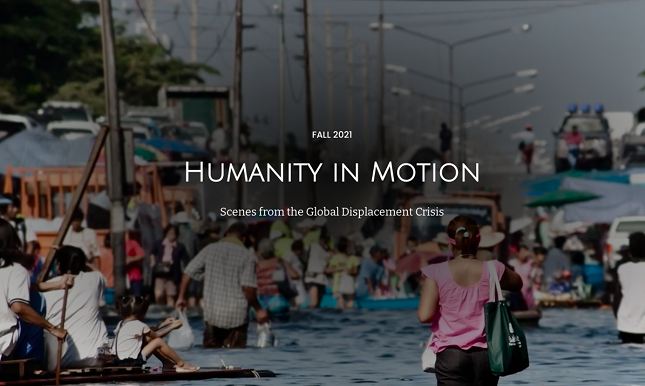-
New Wilson Quarterly Features Expert Insights on Climate Migration
November 5, 2021 By Shruti Samala
“Supporting the talents and potential of the refugees of today could lead to empowering the scientists, leaders, and innovators of the future. Instead of a lost generation, we have the opportunity to build a thriving generation full of promise,” says Abdullah II Ibn Al Hussein, King of the Hashemite Kingdom of Jordan, in the forward of the Fall Wilson Quarterly (WQ), “Humanity in Motion: Scenes from the Global Displacement Crisis.”
The number of forcibly displaced people doubled between 2010 and 2020. Burgeoning conflict and climate change impacts are the main drivers of this spike, with COVID-19 further compounding the crisis by disrupting humanitarian assistance and supply chains, impeding cross-border movement, and straining infrastructure at shelters and evacuation centers.
Drawing on the insight of country leaders, journalists, scholars, and refugees, “Humanity in Motion” investigates displacement today. It sheds light on underexplored aspects of protracted displacement: gendered dimensions of migration, climate-induced displacement, and refugees’ lived experiences. In doing so, the authors seek to answer two core questions: How did we arrive at this point in the global displacement crisis? And what are the paths forward?
Mobility is a defining feature of human civilization, says James Hollifield, a global fellow and public policy scholar with the Wilson Center, in his WQ contribution For most of recorded history, people have moved—voluntarily or involuntarily.
In the 21st century, migration has been recast by globalization—increased mobility has occurred in lockstep with increased free trade, travel, and access to information. These migration patterns yield multiple benefits, like innovation, cultural diversity, foreign exchange, and investment.
Yet, trade-offs exist. “There are costs for the migrants themselves, who leave behind kith and kin at great risk and expense, plunging into the unknown. For receiving states, there are the short-term fiscal burdens of caring for migrants and the dependents, asylum seekers and refugees, as well as the long-term challenges of social and economic integration,” says Hollifield. This cost-benefit calculus emerges within the broader liberal paradox, “which pits the need for economic openness and humanitarian largesse against the need for legal closure to safeguard the institutions of sovereignty and citizenship.” Such tensions are turbocharged by growing nativist backlash against migration and globalization more broadly in receiving countries.
This tense political climate poses a challenge to populations driven out of their homes by conflict and climate change. In a digital experience, Kayly Ober, senior advocate and program manager at Refugees International, presents a dire picture of how conflict and climate impacts are interacting with profound implications for forced displacement. Through examples like Cyclone Amphan, which displaced 2.5 million people in Bangladesh, the nearly 2.2 million South Sudanese who remain in refugee status as a result of political and electoral violence, and the Syrian refugee crisis, Ober explores the complicated interaction of factors that drive a person to move—and the pathways they are pushed to take by forces outside of their control.
In his piece, A Hot Dusty Crossroads, journalist and environmental consultant Peter Schwartzstein details the climate change, migration, and fragility nexus in rural Iraq. Since 2003, environmental degradation has dovetailed with sectarian and jihadist violence. Soaring temperatures, water shortages, and pollution have crippled the agriculture sector, with crop yields plummeting by almost 40 percent in villages across Southern Iraq. Jihadists have controlled and at times even prohibited fertilizer purchases. Since dethroning Saddam Hussein, the presence of U.S. troops at checkpoints in the hinterland has hampered movement of goods and cut off farmers’ access to key markets. Farmers have struggled to adapt alongside deteriorating government services and assistance. Left with little choice, agrarian inhabitants are forced to relocate. In sync with broader migration trends, this movement has been largely internal and to cities, where accelerating urbanization threatens to overwhelm municipalities’ capacity and structures.
Despite the multi-causal drivers of climate-related migration, global conventions do not fully encapsulate the complexities of climate-induced displacement, says Elizabeth Ferris, a research professor at Georgetown University, in her contribution to the WQ. This problem is largely definitional. The multidimensional nature of climate migration complicates binary classifications such as “refugee” and “migrant.” The words “climate” and “environment” are also absent from the 1951 Refugee Convention. And there is the question of whether conditions that climate-displaced individuals confront are fundamentally different from that of those fleeing poverty and violence. Will the former group resettle permanently—as is often the case with the latter—or will they return home to begin reconstruction after a climate-related event?
We need to re-conceptualize existing normative frameworks to align with the changing realities of migration, says Ferris. This includes developing new humanitarian visas for those threatened by natural disasters and incorporating complementary forms of protection within the 1951 Refugee Convention for populations escaping environmental hazards. “The effects of climate change are causing people to move now. Until the world is ready to take bold action, we need to consider how to use existing policies to meet current on-the-ground human needs,” says Ferris.
Read More:
- Displacement, Migration, and Urbanization in the 21st Century
- A Conflict Prevention Agenda Should Inform Climate Change Actions in Africa
- Building Resilience in the Sahel in an Era of Forced Displacement
- Climate Change will Cause More Migration, But that Shouldn’t Scare Anyone
Sources: International Rescue Committee
Photo Credit: Courtesy of Wilson Quarterly.
 A Publication of the Stimson Center.
A Publication of the Stimson Center.






